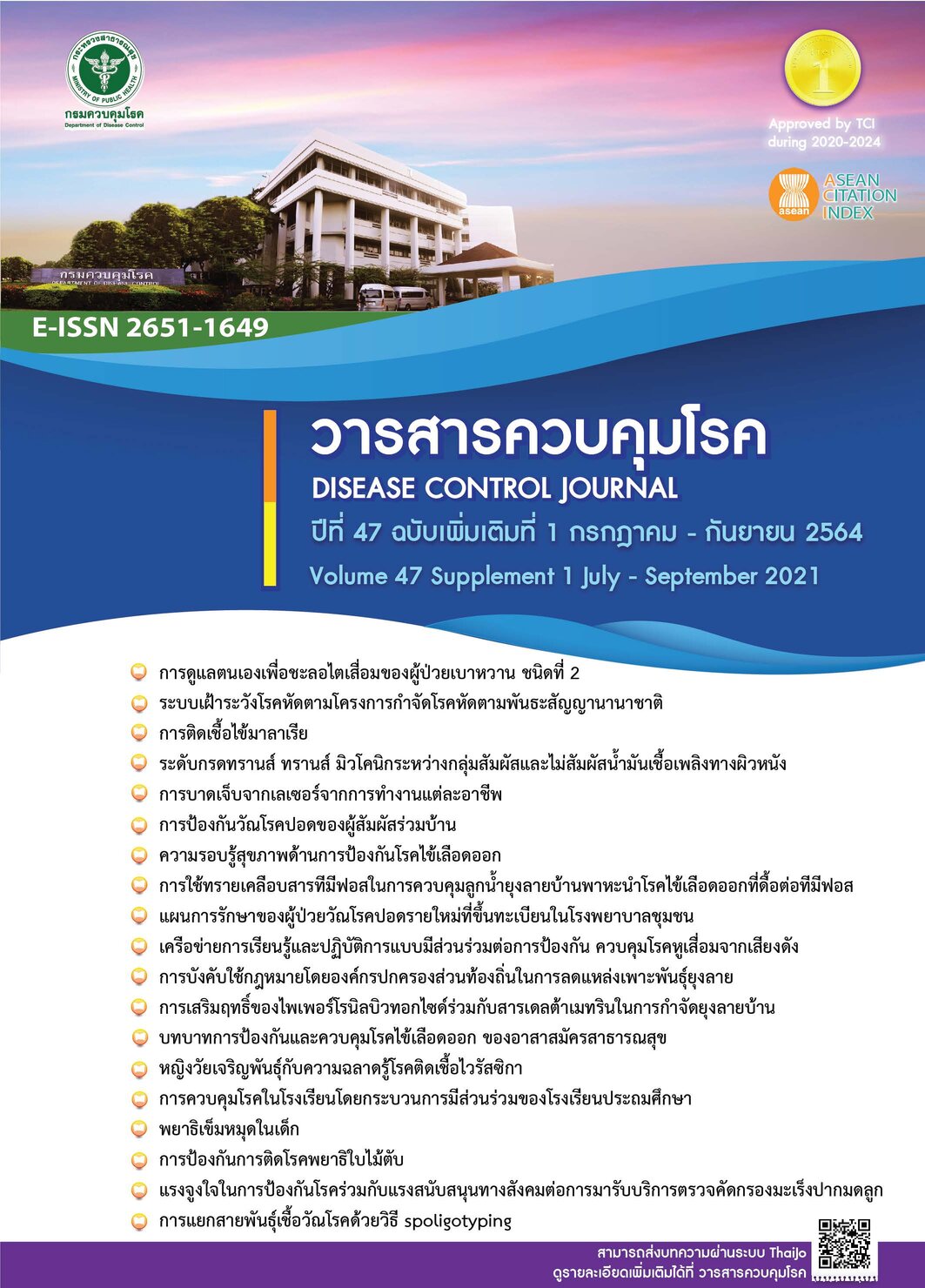Genotyping of Mycobacterium tuberculosis by spoligotyping in the area of The Office of Disease Prevention and Control Region 12, Songkhla
DOI:
https://doi.org/10.14456/dcj.2021.76Keywords:
M. tuberculosis complex, spoligotyping, Provinces under ODPC Region 12Abstract
Tuberculosis (TB) remains an deadly infectious disease causing a serious public health problem in many parts of the world as well as in Thailand caused by Mycobacterium tuberculosis complex (MTC) in which less genotypic diversity data available in Thailand. Genotypic differentiate method is an epidemiological tool (epidemiological investigation and tracking of TB transmission) to differentiate local strains and allow the comparison of strains with global isolates. This study manipulated spoligotyping and aimed to investigate strains circulating in 8 provinces: Songkhla, Yala, Pattani, Narathiwat, Trang, Songklha, Satun and Phatthalung under The Office of Disease Prevention and Control Region 12. A total of 138 MTC isolates collected from pulmonary tuberculosis patients were genotyped by spoligotyping, and the strains were compared with those in the international spoligotype database (SpolDB4). Altogether 15 different spoligotype patterns were identified, and 37 strains were found as new genotype patterns. The East African-Indian (EAI) groups were the most frequent strains investigated followed by Beijing, 36.23% (50/138) and 32.61% (45/138), respectively. Among EAI groups EAI5 were the most commonly investigated followed by EAI6_BGD1 (Bangladesh) and EAI 2_NTB (Nonthaburi), 36.00% (18/50), 30.00% (15/50) and 18.00% (9/50) respectively. This standard and practical spoligotyping is able to identify the diversity of MTC strains circulating in this region.
Downloads
References
World Health Organization. Global tuberculosis report 2018. Geneva: World Health Organization; 2018.
The Office of Disease Prevention and Control region 12 Songkhla. Annual report of Tuberculosis control in the area of The Office of Disease Prevention and Control region 12 Songkhla; 2018.
C Sola, S Ferdinand, C Mammina, A Nastasi, N Rastogi. Genetic diversity of Mycobacterium tuberculosis in Sicily based on spoligotyping and variable number of tandem DNA repeats and comparison with a spoligotyping database for population-based analysis. J Clin Microbiol. 2001 Apr;39(4):1559-65. Doi: 10.1128/JCM.39.4.1559-1565.2001
Sukkasem S, Yanai H, Mahasirimongkol S, Yamada N, Rienthong D, Palittapongampim P, et al. Drug resistance and IS 6110-RFLP patterns of Mycobacterium tuberculosis in Patients with recurrent tuberculosis in northern Thailand. Microbiol Immunol. 2013;57:21-9.
Faksri K, Drobniewski F, Nikolayevskyy V, Brown T, Prammananan T, Palittapongampim P, et al. Epidemiological trends and clinical comparisons of Mycobacterium tuberculosis in Thai TB meningitis. Tuberculosis. 2011;91:594-600.
Noguti EN, Leite CQF, Malaspina AC, Santos AC, Hirata RD, Hirata MH, et al. Genotyping of Mycobacterium tuberculosis isolates from a low-endemic setting in northwestern state of Parana in southern Brazil. Mem Inst Oswaldo Cruz. 2010;105:779-85.
Githui WA, Jordaan AM, Juma ES, Kinyanjui P, Karimi FG, Kimwomi J, et al. Identification of MDR-TB Beijing/W and other Mycobacterium tuberculosis genotypes in Nairobi, Kenya. Int J Tuberc Lung Dis. 2004;8:352-60.
Phetsuksiri B, Bunchoo S, Rudeeaneksin J, Srisangngam S, Noppornpun K, Khummin R, et al. Genotyping of Mycobacterium tuberculosis by spoligotyping. Journal of Health Science. 2017;26:447-55.
Centers for Disease Control and Prevention. Guide to the application of genotyping to tuberculosis prevention and control [Internet]. 2012 [cited 2019 Jun 9]. Available from: http://www.cdc.gov/tb/programs/genotyping/chap3/3_cdclab_2description.htm.
Adwoa Asante-Poku, Isaac Darko Otchere, Stephen Osei-Wusu, et al. Molecular epidemiology of Mycobacterium africanum in Ghana. BMC Infect Dis. 2016; 16: 385.Published online 2016 Aug 9. doi: 10.1186/s12879-016-1725-6
Hasan z, Tanveer M, Kanji A, Hasan Q, Ghebremichael S, Hasan R. Spoligotyping of Mycobacterium tuberculosis isolates from Pakistan reveals predominance of Central Asian Strain 1 and Beijing isolates. J Clin Microbiol. 2006;44:1763-8.
Brudey K, Driscoll JR, Rigouts L, Prodinger WM, Gori A, Al-Hajoj SA, et al. Mycobacterium tuberculosis complex genetic diversity: mining the fourth international spoligotyping database (SpolDB4) for classification, population genetics and epidemiology. BMC Microbiol. 2006;6:1-17.
Phetsuksiri B, Rudeeaneksin J, Srisungngam S, Bunchoo S, Rienthong D, Mukai T, et al. Applicability of inhouse loop-mediated isothermal amplification for rapid identification of Mycobacterium tuberculosis complex grown on solid media. Jpn J Infect Dis. 2013;66:249-51.
A G M van der Zanden, K Kremer, L M Schouls, et al. Improvement of differentiation and interpretability of spoligotyping for Mycobacterium tuberculosis complex isolates by introduction of new spacer oligonucleotides. J Clin Microbiol. . 2002 Dec;40(12):4628-39.
doi: 10.1128/JCM.40.12.4628-4639.2002.
Eldholm V, Matee M, Mfinanga SG, Heun M, Dahle UR. A first insight into the genetic diversity of Mycobacterium tuberculosis in Dares Salaam, Tanzania, assessed by spoligotyping. BMC Microbiol. 2006;6:76.
Bifani PJ, Mthema B, Kureµl. na NE, Kreiswirth BN. Global dissemination of the Mycobacterium tuberculosis W- Beijing family strains. Trends Microbiol. 2002;10:45-52
Van Anh Thi Nguyen, Marc Choisy, Duy Hung Nguyen, et al. High prevalence of Beijing and EAI4-VNM genotypes among M. tuberculosis isolates in northern Vietnam: sampling effect, rural and urban disparities. PLoS One. 2012;7(9):e45553.
doi: 10.1371/journal.pone.0045553. Epub 2012 Sep 24.
Tran N, van Soolingen BD, Huyen MNT. Increased transmission of Mycobacterium tuberculosis Beijing genotype strains associated with resistance to streptomycin a population based study. PLoS One. 2012;7:e42323.
Sujariyakµl. A, Rudeeaneksin J, Tipkrua N, Phetsuksiri B. Epidemiology and genotypes of Mycobacterium tubercolosis at an outbreak area in Kanchanaburi province. Disease Control Journal. 2016;42;337-47.
Jurriaan E.M. de Steenwinkel, Marian T. ten Kate, et al. Drug Susceptibility of Mycobacterium tuberculosis Beijing Genotype and Association with MDR TB. Emerg Infect Dis. 2012 Apr; 18(4): 660–663.
M. Keikha and M. Majidzadeh. Beijing genotype of Mycobacterium tuberculosis is associated with extensively drug-resistant tuberculosis: A global analysis. New Microbes New Infect. 2021 Sep; 43: 100921. Published online 2021 Aug 1. doi: 10.1016/j.nmni.2021.100921
Downloads
Published
How to Cite
Issue
Section
License
Articles published in the Disease Control Journal are considered as academic work, research or analysis of the personal opinion of the authors, not the opinion of the Thailand Department of Disease Control or editorial team. The authors must be responsible for their articles.






